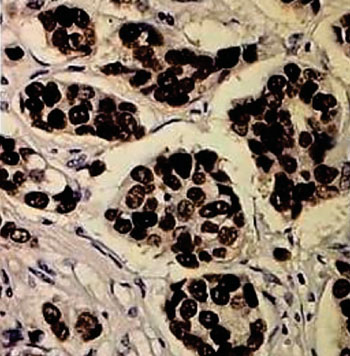Multigene Test Identifies Early Breast Cancer
By LabMedica International staff writers
Posted on 30 Mar 2016
The 21-gene Recurrence Score (RS) assay, nodal status, grade, and immunohistochemical markers are recommended for chemotherapy decision making in hormone receptor positive/ human epidermal growth factor receptor negative (HR+/HER2–) early breast cancer (EBC).Posted on 30 Mar 2016
HR+ means the breast cancer is hormone receptor positive, indicating the cancer cells have high numbers of receptors for estrogen (ER) or progesterone (PR) on their surfaces, allowing the hormones to drive cancer growth. HER2 negative (HER2−) means the breast cancer cells do not have high numbers of epidermal growth factor receptors and so will not respond to treatment with trastuzumab (Herceptin) and other therapies that target HER2.

Image: Immunochemistry of receptors for estrogen (ER), strong and diffuse nuclear staining in a tissue sample from a breast cancer patient (Photo courtesy of Steven Halls, MD).
Scientists at the West German Study Group, Clinical Research (Mönchengladbach, Germany) prospectively used RS to define a low-risk subset of patients with node negative disease with high risk traditional parameters and patients with node positive disease (HR+, HER2−) who could be treated with adjuvant endocrine therapy alone. From 2009 to 2011, they enrolled 3,198 patients; median age of 56 years; 41.1% had node-positive and 32.5% grade 3 disease. The 21-gene RS test analyzes 21 genes that can influence the development of cancer and how it responds to treatment. The test result is a number from 0–100.
The patients were classed as either medium or high risk (RS score over 25) and were randomized to receive one of two types of chemotherapy: six cycles of docetaxel/cyclophosphamide or four cycles of epirubicin/cyclophosphamide followed by four cycles of docetaxel. After a median follow-up of 55 months, the investigators found that 94% of patients in the hormonal-therapy only group (the ones whose gene test predicted they had a low risk of recurrence), were still alive and disease-free five years after diagnosis. Of the higher risk patients who received chemotherapy as well as hormonal therapy, those classed as medium-risk patients also showed a 94% disease-free survival five years after diagnosis, while for the high-risk patients, this figure was 84%.
Oleg Gluz, MD, one of the study coordinators, said, “In this prospective trial for patients who had a clinically-determined intermediate or high risk of recurrence and who had 0–3 lymph nodes involved, we have been able to identify about 15% who were assessed by the 21-gene RS as being at low genomic risk. We were thus able to treat them by anti-hormonal therapy alone and to spare them chemotherapy. The 94% disease-free survival rate that we observe after five years without adjuvant chemotherapy is an excellent result.” The study was presented at the 10th European Breast Cancer Conference (EBCC-10) held March 9-11, 2016, in Amsterdam (The Netherlands).
Related Links:
West German Study Group













